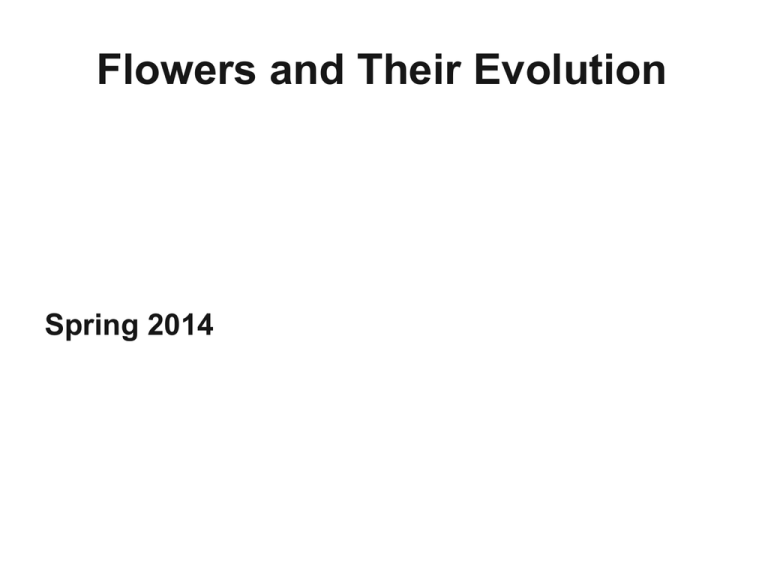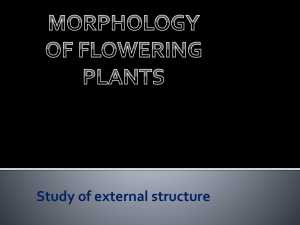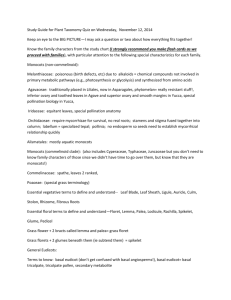Flowers
advertisement

Flowers and Their Evolution Spring 2014 Flower = a short, determinate shoot bearing highly modified leaves, some of which are fertile (i.e., bearing either microsporangia or megasporangia), with the microsporangia in stamens and the megasporangia in carpels. Flower • REPRODUCTIVE STRUCTURE – Evolutionary requirement to reproduce by sexual means. Pollen transfer and seed dispersal needed. • MODIFIED FOLIAR APPENDAGES – all function together to form the reproductive organ known as the FLOWER. • MODIFICATIONS OF LEAVES – All floral organs are modified LEAVES. Four terminal WHORLS of modified leaves: - Two outermost whorls (sepals, petals) are sterile (nonmeiotic tissues) - Two innermost whorls (sporophylls) are “fertile” with tissues capable of undergoing meiosis • SPOROPHYLLS – those modified leaves with meiotic capacity. - Microsporophylls – stamens – produce pollen in anthers - Megasporophylls – carpels – produce eggs in ovules Fig. 6.2 from Simpson Floral Whorls • Attached to RECEPTACLE • Sepals (collectively the Calyx) • Petals (collectively the Corolla) • Stamens (anthers + filaments) • collectively the Androecium (andros = male; -oecium = house) “Pistil” – carpel(s) [fused or not] collectively the Gynoecium (gynos = female; -oecium = house) Floral Parts: Major whorls pistil (1-many carpels) - gynoecium stamens - androecium petals - corolla sepals - calyx receptacle stamen pistil Sepals and petals are relatively leaf-like. young leaves XS of flower bud sepal petal “ABC” Model of Floral development Fig. 6.5 from Simpson Floral Anatomy Evolution of the Androecium • • • DERIVED FROM MODIFIED LEAVES - Microsporangia (meiosis microspores pollen grains) on lamina originally INCREASING LEVELS OF REDUCTION - Lamina becomes filament - Sporangial tissue becomes anther wall - Provides for release of pollen CAN BE IN A SINGLE WHORL OR MULTIPLE WHORLS - Tremendous variation in flowering plants. - Often associated with specific type of pollinator. Stamen evolution microsporangia laminar stamens Fig. 9.26 Fig. 9.25 Floral Anatomy Evolution of the Carpel • • • • • MODIFICATION OF MEGASPOROPHYLL - Evolution of megasporophyll structure traced back to seed ferns – 200 to 300 mybp LEAF WITH MARGINAL MEIOTIC ZONES FOLDS - Ovules located at margins of sporophylls - Lamina curves inward (toward the floral axis - adaxially) - Carpel is formed by folding – conduplicate - Margins fuse, enclosing ovules - Carpel(s) = gynoecium FUSION OF CARPELS - Unfused (separate) carpels - apocarpous - Fused (united) carpels - syncarpous POSITION OF THE GYNOECIUM relative to other floral whorls is important in describing floral structures. PLACEMENT OF OVULES (placentation) within the gynoecium is also important; shows evolutionary origins of the carpel. The Ovule = integumented megasporangium sporangium female gametophyte (derived from a single spore) integuments micropyle Carpel evolution (Ovules) (megasporophyll) Folding of megasporophyll to form simple carpel Folding of one megasporophyll S = suture; formed by fusion of leaf margins; receptive to pollen receptacle Carpel evolution stigma stigmatic crest 3 pistils Fig. 9.30 from Simpson 1 pistil Simple Carpel – One Pistil Apocarpy – Separate Carpels = 5 pistils in this example Apocarpous gynoecium – Ranunculus sp. with many pistils elongated receptacle Liriodendron Magnolia Simple vs. compound ovary Fig. 9.31 from Simpson Syncarpous gynoecium – One pistil, 3 carpels Various gynoecia – Apocarpous vs. Syncarpous (Hint: stigma number usually = carpel number) Syncarpy – How many carpels? Locules? Adnation: Fusion of different whorls Stamens (filaments) adnate to petals, petals adnate to sepals Connation: Fusion of parts from the same whorl Fusion of filaments into a staminal tube Ovary position relative to other parts Fig. 9.32 from Simpson The hypanthium (floral cup) requires both connation and adnation. Ovary superior Parts hypogynous Citrus sp. Ovary superior, parts perigynous (floral cup or tube = hypanthium present) Rosa sp. Ovary inferior, parts epiperigynous (hypanthium present) Fuchsia sp. Ovary inferior, parts epigynous Vaccinium sp. Ovules and Placentation • • • • OVULES CONTAIN THE MEGAGAMETOPHYTE - Provides for fertilization of egg cell in megagametophyte and protection during development. - Ovule matures into the SEED. ATTACHMENT OF THE OVULES VIA FUNICULUS - Analogous to the mammalian “umbilical cord” - Point of attachment on inner ovary wall is the PLACENTA - Can vary depending on type of flower. PLACENTATION IS OFTEN DIAGNOSTIC - Plant families typically have one placentation type. - Often best seen with cross section through ovary. PLACENTATION REFLECTS EVOLUTIONARY DEVELOPMENT - Fusion of carpels, presence of vascular bundles, etc. can support hypotheses about evolution of particular flower structures. Fig. 9.33 from Simpson Fig. 9.33, Part A only Placentation Axile Parietal Floral Symmetry Radial Bilateral Actinomorphic Zygomorphic Merosity = basic number of parts in each whorl -3 sepals, 3 petals, 6 stamens, 3 carpels = 3-merous (or trimerous) -4 sepals, 4 petals, 6 or 8 stamens, 2 or 4 carpels = 4-merous (or tetramerous) -5 sepals, 5 petals, 5 or 10 stamens, 3 or 5 carpels = 5-merous (or pentamerous) Interpretation of Floral Structures • • • • • OBSERVE STRUCTURES IN EACH WHORL - How many whorls are there? - How many parts are present in the calyx? Corolla? - Describe the androecium, then the gynoecium. DETERMINE POSITION OF THE FLOWER PARTS RELATIVE TO THE OVARY - Hypogynous? Perigynous? Epigynous? Epiperigynous? GYNOECIUM - Apocarpous? Syncarpous? If so, how many carpels? - Position? Superior or inferior or half-inferior? - Placentation? ADNATION or CONNATION? - Fusion of floral parts can sometimes be diagnostic. UNUSUAL OR REMARKABLE FLORAL STRUCTURES? - Specializations for pollination?











